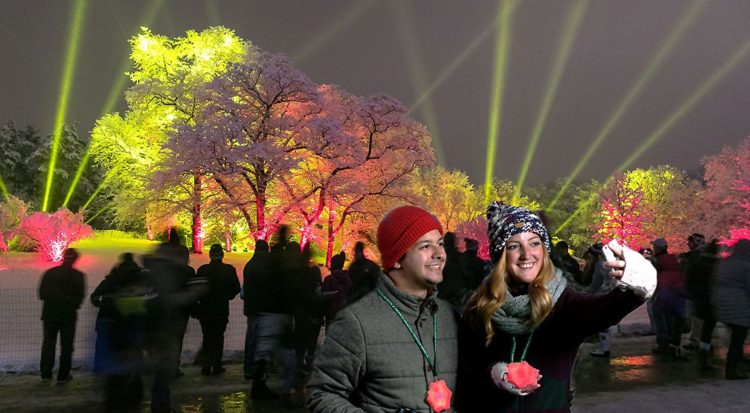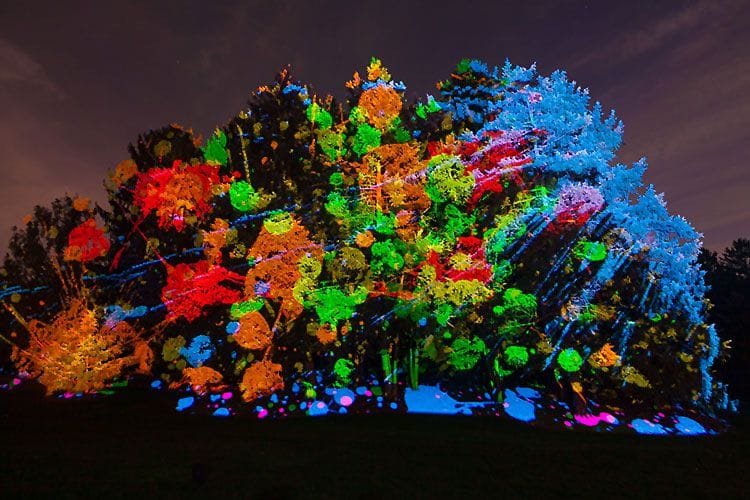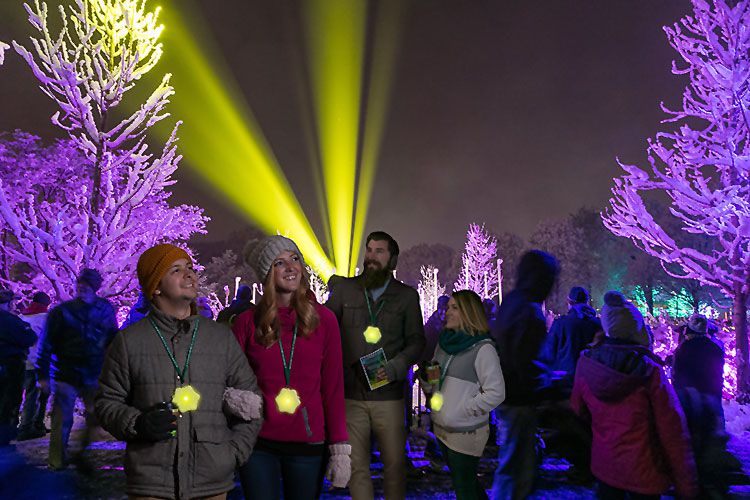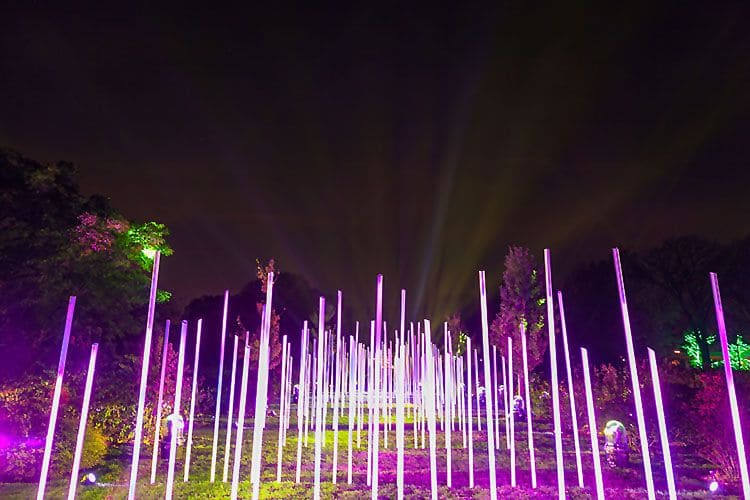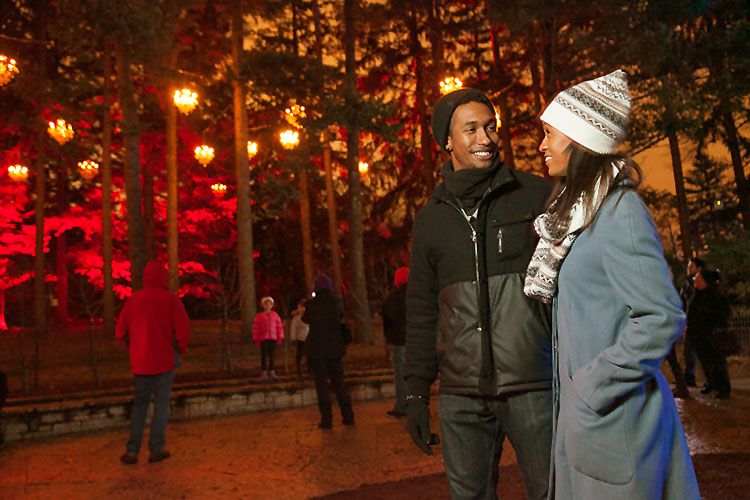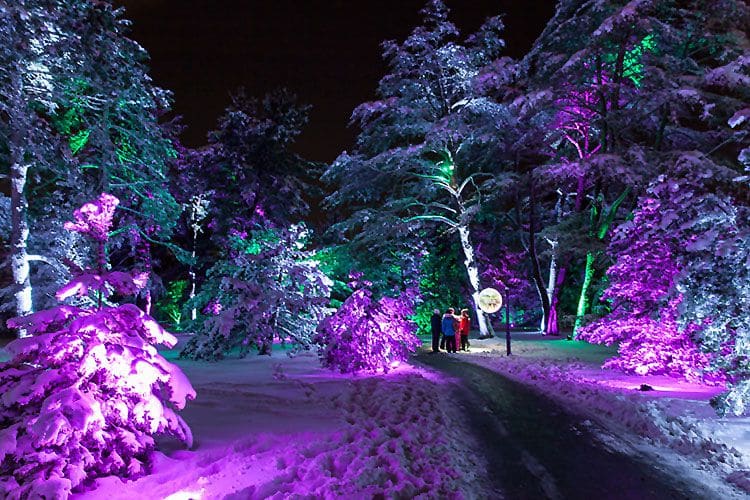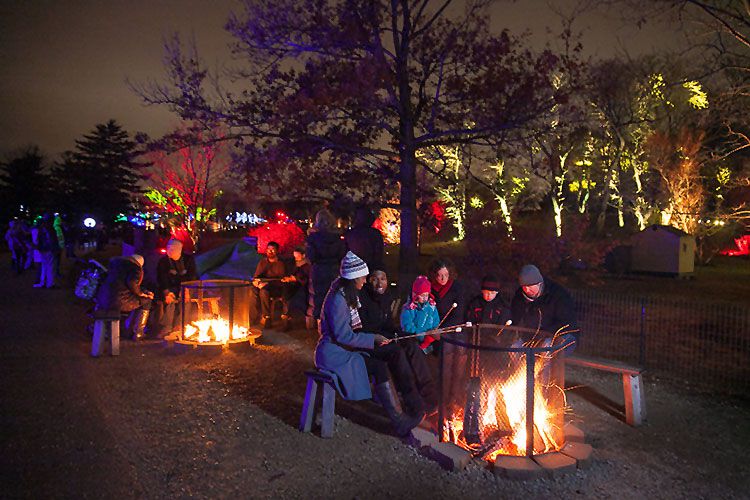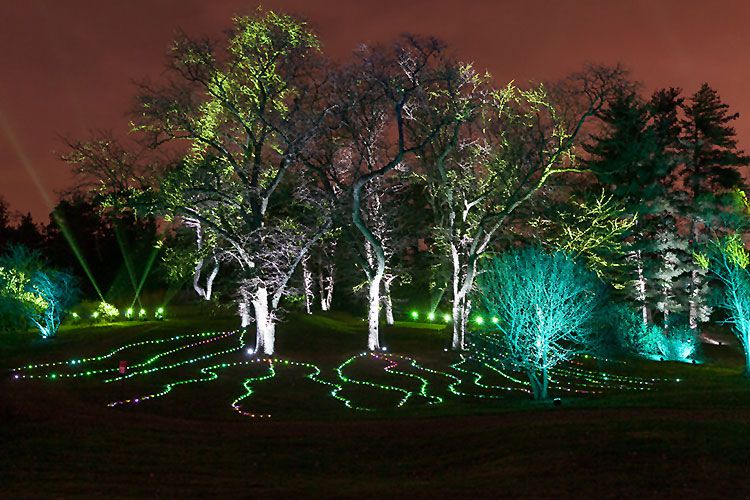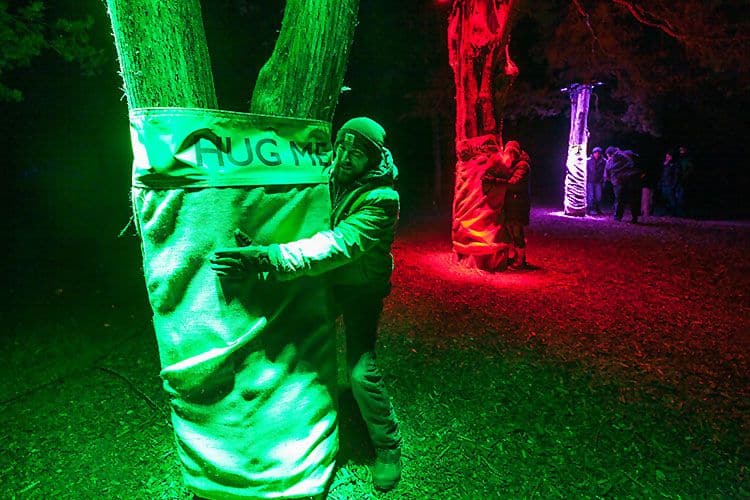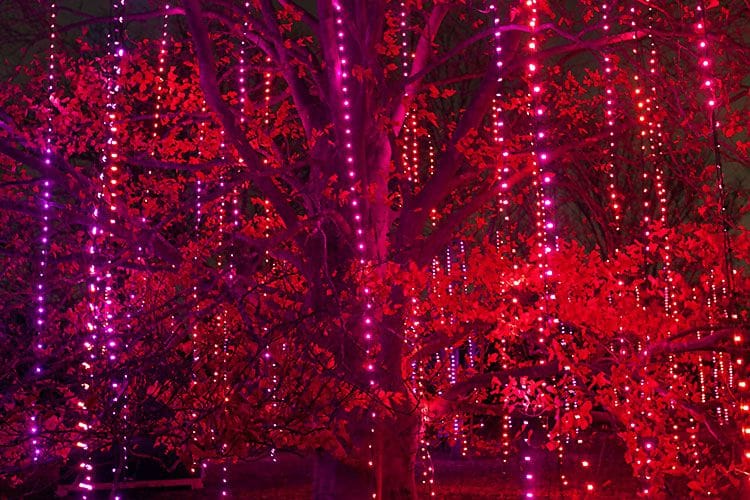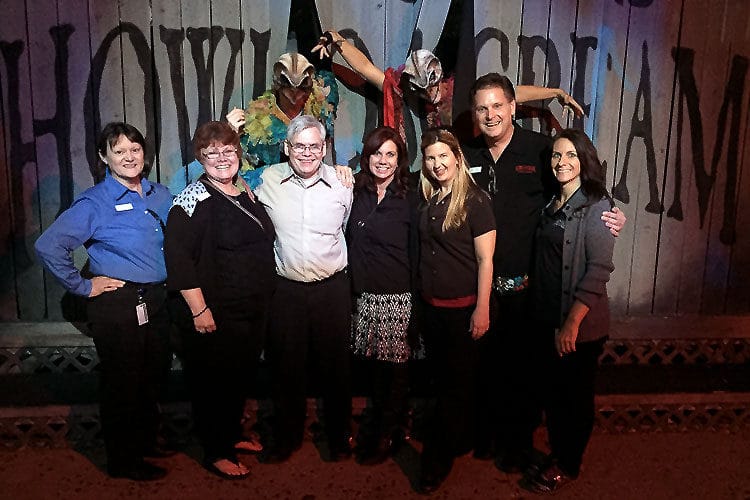Welcoming more than a half-million visitors to “see trees in a different light” on a one-mile walk through 50 acres of trees The Morton Arboretum’s ‘Illumination’ seasonal event was born from partner trust, an established purpose, and meaningful metrics.
In this article, we use The Morton Arboretum’s Illumination as a case study for the value to nonprofits (and museums, aquariums, attractions of all spaces) of offering seasonal events. We delve into the specifics of how and why the Arboretum decided to do this event, what the challenges were, and what the benefits have been.
ABOUT MORTON ARBORETUM
The Morton Arboretum, located in Lisle, Illinois, was founded in 1922 by Joy Morton (1855-1934). The inspiration for the Arboretum had its origins in Mr. Morton’s family tree. His father, J. Sterling Morton (1832–1902), was the founder of Arbor Day. Over the decades, the Arboretum has continued to evolve while staying true to the Morton family motto, “Plant Trees.”
The mission of the Morton Arboretum is “to collect and study trees, shrubs, and other plants from around the world, to display them across naturally beautiful landscapes for people to study and enjoy, and to learn how to grow them in ways that enhance our environment. Our goal is to encourage the planting and conservation of trees and other plants for a greener, healthier, and more beautiful world.”
SUCCESS STORY: ‘ILLUMINATION’
In 2013, The Morton Arboretum launched its seasonal exhibit, “Illumination: Tree Lights,” which “brings light and Nature together for a wintertime walk in the woods like no other.” Visitors “see trees in a different light” on a one-mile walk through 50 acres of trees, which are among the Arboretum’s 1700 acres of botanical delight. LED lights, interactive elements, and sound accentuate the trees. Live entertainment and warming stations add to the wintertime experience.
Illumination is now a winter tradition, welcoming more than a half-million visitors from throughout the United States as well as Canada, the United Kingdom, and Germany. The experience is crafted in partnership with experiential lighting designers Lightswitch and production company Intelligent Lighting Creations (ILC) and uses energy-efficient, eco-friendly LED lighting.
The guest experience: majestic trees glowing in mesmerizing hues of blue, green, purple, and magenta greet you. A grove of hemlock trees upon which deeply saturated colors and projected geometric patterns appear next. You’re invited to ‘Hug a Tree’ and watch it respond, enjoy a dazzling show of trees dancing in time to music, a field of ornaments, and watch trees breathing.
Last year’s event included a new way to become part of the Illumination experience: the Illu-medallion. The Illu-medallion is a programmed, interactive pendant that lights up in sync with various aspects of the event. Illu-medallions, worn on a lanyard, change color, intensity, and pulse in response to the features that guests encounter on their journey for a truly interactive experience. Guests can buy Illu-medallions in The Arboretum Store or at concessions tents along the Illumination route on the night they visit. Guests were able to continue to enjoy their Illu-medallion at home, and it is re-used during any subsequent visit to Illumination—during the same year or in the future.
Each year’s event takes a full year of planning, and a team of 25 designers, technicians, and crew work for more than a month to install the lights for Illumination. Fantasy Forest, Illumination’s grand finale, took six months of design time and testing to perfect and more than two weeks to program. Illumination’s lights are connected and coordinated by 20 miles of cable. For comparison, that’s the distance from Lisle to the city limits of Chicago!
“Last year was our fifth season of encouraging visitors to see trees in a different light, with new and returning elements and new ticket options to enhance the Illumination experience for our guests,” said Sue Wagner, Vice President of Education and Information at The Morton Arboretum. “Illumination surprises and delights visitors with luminous color, light, and sound that transforms 50 acres of trees into something truly magical.”
ILLUMINATION SHOWS THE VALUE OF OFFERING SEASONAL EVENTS
After touring this breathtaking event on a 13-degree night in November, we later interviewed the Arboretum’s Vice President of Education and Information at Morton Arboretum, Sue Wagner, and asked her if she considers Illumination a success and how Morton Arboretum measures success.
“We define success with Illumination in a number of ways,” she replied. “One of the ways is net revenue. Another metric is whether we’re attracting new audiences to the Arboretum. A third measure is our reputation. We look at our net promoter score (NPS) to understand if Illumination is earning a good score and affecting the overall Arboretum NPS. We also look at our marketing to see if we’re attracting a higher proportion of nonmembers versus members. We then look at nonmembers who attend Illumination to try to find out if these are people who wouldn’t normally come to the Arboretum and whether they’re part of the population surrounding us,” she said.
“With Illumination, we noticed that we’re significantly attracting a greater percentage of nonmembers versus members. We’d set a target for attendees at Illumination of 50% members and 50% nonmembers. We discovered that about 62% of attendees at this event are nonmembers. Historically, attendance at our events skews heavily toward members, and regular attendance at the Arboretum during daylight hours is about 11% nonmembers,” she explained.
“I want to clarify what I just said because there’s a compounding factor. If we’re offering an exhibit—which we usually do during the summer—we’re going to see that proportion of members to nonmembers change if the exhibit appeals to a higher number of nonmembers. That being said, with Illumination, we’ve significantly increased the number of nonmembers coming to the Arboretum. In many cases, these are people who are coming to the Arboretum for the first time.”
Adhering to the mission
“In-house, we consider Illumination one of our exhibits. It’s just open at night,” she explained.
We asked Sue to explain why Illumination is considered an exhibit and not an event and the difference between the two.
“Internally, we perceive Illumination as an exhibit. There are a number of different galleries that people experience along their walk. In those galleries, there are interactive experiences, visual experiences, or auditory experiences. In our interpretation panels, we have ‘teaser’ tree expertise which is shared with the public. In this way, the public sees the connection of the Illumination experience to our mission,” she said.
“We have a very functional team that works together across all departments to create this visitor experience for members and nonmembers. The public views Illumination as ‘a thing to do.’ They may not think of it as an event.”
Wagner pointed out that even though Illumination contains the ingredients of and is viewed as an exhibit by the staff at the Arboretum, the word “exhibit” isn’t used. “The word ‘exhibit’ can conjure up adjectives like ‘dusty,’ ‘old,’ ‘museum.’ We want people to experience trees at a time when they’re not thinking about trees. The trees are, in fact, waiting to spring into action. We’re getting people to see trees different. Our data indicates that we’re successfully doing this,” she stated.
“For example, in Treemagination, the audience is walking through our conifer collection and comes upon these vivid, brightly colored trees that have a psychedelic feel. Then there’s an interruption of that experience in which the trees appear to be taking in something—carbon, which they store in their roots. The audience sees the trees expanding and contracting as if breathing, which is accompanied by a sound effect of breathing. People take away the idea that trees breathe. They’re living things, and they provide us with oxygen. This isn’t done in a contrived way, and it’s far from a boring demonstration in a gallery. It’s taking place in a living space, and theatrical lighting effects are drawing out the activity of the tree, which otherwise appears to be nonactivity,” stated Wagner.
“Our goal is to weave a magical experience with a strong interpretive element for those who want a more informative experience. For those who want just to have fun, we have our event-based planning as well. We have our events team and visitor services, who carry out the customer-service component. We have our grounds and horticulture staff that contribute to the beauty of the experience. We think through the customer journey together, and that helps us knit together what we’re doing to create a surprising and delightful experience for the customer.”
The Requirement for Greater Infrastructure
“Because Illumination attracts a large number of people and has logistical issues that we don’t experience during the day, we use statistics to determine and plan for how many people come during what time of the day, where to put the cars, how to manage snow removal. We walk through scenarios. We now understand how inclement—or even terrible—weather impacts the visitor experience so we can address issues with parking, etc.”
Wagner continued, “Timed ticketing has made a big difference in the quality and satisfaction of the visitor experience, and it’s also improved staff morale because it provides a way to manage surges in attendance. Timed ticketing allows every visitor enough time to enjoy Illumination and leave with an emotional souvenir,” she said.
“We have to be much more attentive to detail than when we combine an exhibit with programming events where we don’t have these surges in attendance. On its busiest nights, Illumination has maybe 6,500 people. That’s a lot of people. We need working bathrooms, ice-free walkways, and be sure the hot chocolate is hot!”
Crafting Emotional Souvineers
Illumination features refuges throughout the event—calm, warm places where one can stand by the fire, look out into the trees, and reflect on the experience. These areas of reflection, said Wagner, is a recipe for creating what she calls an “emotional souvenir.”
“Another example of the emotional souvenir is when family units or social groups of whatever kind come together in front of Symphony Woods and listen to the music of ‘The Nutcracker’ together. We chose that music purposely because it triggers nostalgia. We want the trees to express the symphonic music. Sometimes, people hum along with the music or start dancing to it. When we’ve asked in surveys what people most remember about Illumination, many cite Symphony Woods, because they feel an emotional connection to it. We’ve created a memory. That memory embeds in our guests the motivation to come back to the Arboretum and have the experience again,” she explained.
“We want to improve and tweak experiences, so the experience is more likely to craft emotional souvenirs for the visitor. On the other hand, there are some experiences we don’t want to change. Hug a Tree, Symphony Woods, and Treemagination are the ones that visitors report resonating with the most. They’re either visually unique, or there’s a visceral component to them. These are the experiences we don’t want to change because we want the visitor to come back and know they can have that experience again,” said Wagner.
Pay Attention To the Data
“Our data for this year show that the primary reason people come to Illumination is to celebrate the holidays, with 62% of people stating that. The second most popular reason was to experience something new, and 30% of people cited that. They want something that feels comfortable but unique,” she explained.
“To a lot of people, the Arboretum is an unknown. So what we’ve done is open ourselves up as a place to go for the holidays and, in doing so, we’ve opened ourselves up to a whole new world of people. A lot of our visitors are people who want a place to bring family and friends. Interestingly, nearly 50% of our survey-takers report they want to do something fun by themselves, but with other people, so they don’t feel out of place. Illumination offers this. It’s great for date night, families, and social groups. About a third of our visitors come with one other person, and then the next ranked grouping is five or more people.”
The Blue-sky Conversation
“We looked at our seasonal programming to determine where we needed to support our attendance and to determine where the gaps were. The main gap was in winter, especially deep winter. We looked at our competition and saw there were a lot of things going on during the holidays. It would be unexpected for people to come to the Arboretum,” she said.
“We appeal to people who want to spend time outdoors, so we came up with the idea of a holiday light experience but making it about the trees and not the lights.”
Staff Buy-In is Critical
“Once the President and board bought in, the next step was getting staff buy-in. This is a big endeavor and something they’d never done before. The visitor experience creation process was broken down into bite-size pieces and then scaled up quickly again. We had marketing drive a lot of the benchmarking. Understanding our Chicago market was critical. Our marketing team developed a marketing plan that was very successful the first year. We exceeded our targets the first year because our staff saw the value in this event and pulled together,” Wagner explained.
“The design phase was fun, especially when we decided on what to call this thing. Marketing and design helped us bring the look and feel of the experience into what we named it: Illumination.”
Partner Trust, a Clear Purpose, and Meaningful Metrics
“John [John Featherstone of Lightswitch] and his team have been great partners. He understands the mission—that we’re here to protect and plant trees. He understood, right away, this wasn’t going to be just a holiday light show. He adopted our goals, and he feels like part of our Arboretum staff. We share all our visitor data with his team, so he knows the visitors’ perceptions. He tells us where to push and think bigger, and we tell him where we want to think bigger or ideas for bringing in more visitors, and we’re all on the same page. We have open, honest communication.”
Linking Mission to Event
When we walked through Illumination, the connection between the event and the Arboretum’s mission struck us. Everything about Illumination is in alignment with the Arboretum’s purpose and mission. The alignment is palpable, primarily because of the high degree of interactivity.
“We’re an Arboretum—we focus on trees and woody plants. Illumination brings light and Nature together in this wintertime walk. It invites visitors to see trees in a whole different way. Although it’s a pun, our slogan, ‘We want people to see trees in a new light,’ it’s also true. Illumination is the first step to getting people to fall in love with trees, think more about them, and become more conservation-minded. Illumination expresses our mission in a unique and interactive experience. People become part of the ecosystem.”
In summary, Wagner stated, “Illumination is a great fit for us regarding our mission, and it’s been hitting all of the marks in terms of measuring our success.”
THE BACKSTORY FROM JOHN FEATHERSTONE
As mentioned, Illumination is a very different “exhibit” than what The Morton Arboretum usually does. We asked John Featherstone, founder of Lightswitch Lighting and Design, about the challenges of developing Illumination.
“The biggest significant difference between Illumination and other events at The Arboretum (except for a few summer concerts) is it’s the only thing they do in the evening. Illumination started with a very blue-sky ‘what if’ call. It wasn’t even as defined as ‘Let’s do a holiday lights experience.’ It was more, ‘How can we expand the boundaries of what the Arboretum does and the way we reach out to our guests?’ As a lighting designer, my response, of course, was why not have an evening event? The response was, ‘We’re not open at night.’ I said, ‘But you could be.”
Featherstone continued, “It was a big stretch for the Arboretum to change from a one-staffing-cycle-a-day institution to a two-staffing-cycle-a-day institution. The challenge of bringing in 1200 lights and all the technologies pales in comparison to all the HR difficulties and the logistics of the Arboretum. It’s not just about bringing in new technologies; it’s about rethinking everything—from staffing to guest management to hospitality services to parking,” he said.
Mission-Based Design
“We’re interested in exploring a different space, and that space is the notion of the interaction of humans and Nature in a winter environment. In the Midwest, this relationship is bipolar. There’s an embedded relationship between people and Nature in Spring, Summer, and Autumn, but, in Winter, everyone stays in their cars. We wanted to explore the idea that trees are no more dead in winter than you and I are when we’re asleep. The trees are resting and, with the conifers, they’re growing. Certain parts of the planet would deoxygenate if this weren’t the case,” Featherstone explained.
“Make trees the star of the show—make them ‘scenery’ in the true sense of the word, not in a theatrical sense—and support Morton’s mission of being ‘the champion of trees.’ Making the trees the stars is the touchstone for everything we do—whether it’s as visceral and engaging as Hug a Tree, something as symphonic and grand as Symphony Woods, or something as interactive and immersive as using the medallions to change the lighting on the trees. The trees are front and center,” he said.
Illumination provides a holiday event whose design works within the constraints of the Arboretum’s mission. “You can find Christmas lighting displays everywhere, especially in the Midwest… With Illumination, we wanted a very distinct feel, and one aspect of that is the participatory element. We’ve explored a lot of interactive technologies, some of which are in Hug a Tree, Tinsel Harmony, and using physical or vocal methodologies to interact.”
When Design Meets Environmental Challenges
Featherstone continued, “Another challenge at the Arboretum is cold. We have an interesting duality—people’s patience for waiting is very low because they get cold, and that’s why it’s set up as a walking trail. So, people want to keep moving; they don’t want to take their gloves off, and, much of the time, they’re bundled up. At the same time, we wanted that interactivity component. The Medallion resonated with us because it’s nonparticipatory interactivity. I know that sounds like double-speak, but what I mean is it’s an interactive experience when you buy the medallion. From that point on, you become embedded in the show, and you become a pixel. It gives us a level of interactivity that lets people explore the park, walk briskly, not stand in line, and creates a sense of connective tissue between the people in the experience and the experience itself,” he said.
Featherstone continued, “No matter where we go with the medallion, we have a pledge from Gantom [Gantom manufactured the Medallion, which is powered by Torch Technology] regarding compatibility; people will be able to bring their medallion back year after and it will always be part of the experience. We didn’t want it to be a throwaway that gets tossed into the back of the junk drawer. It’s a high-quality, tactile, durable kind of thing. It feels like it has value… It’s not a passive experience but an active, participatory, engaging dialogue between the visitor and the installation.”
Thick Experiences
We noted to John that points of engagement happen thoughtfully. “We spend a lot of time mapping a conscious guest experience. The conscious nature is one of the main differences between Illumination and a traditional holiday display, which is ‘look at it and leave.’ People connect to the Arboretum in the warm months. People get married there, have picnics, listen to concerts. These are genuinely engaging, emotional, connective experiences. For anybody, spending time in a natural environment in those warmer months connects with us on a deeply human level. To not have given as much thought to what people will experience in the winter would not only have done our client, the Arboretum, a disservice, it would have left exciting spaces unexplored,” he stated.
John described Illumination as a thick experience, “as this thick, viscous experience that sticks to you emotionally. That’s what we see with Illumination… It’s sticky. People love it. They love coming back again and again. They love bringing their family and kids,” he said.
“We were wobbling on the edge of being a novelty for the first few years, but now we’re five years in and we’ve transitioned into being a tradition. What comes next… is the transition into becoming an institution. For example, the area in the Arboretum where the chandeliers are has become a traditional proposal spot, and people come back to the Arboretum to get married. That’s how a facility moves from being a beloved institution to being part of someone’s life.”
Trusted Partnerships and Shared Vision
“These Arboretum people trust us. We come up with these hare-brained ideas, and they let us go with it. They’re so collaborative and trusting. John expands on the ‘hare-brained’ interactive elements. “We want people to touch everything, touch every tree, turn every dial, be part of every experience. Hug a tree, sing to a tree. We want people to see what happens when they push a button longer or turn a dial the other way. We want that sense of play, wonder, and discovery; that needs to be in the DNA of the experience. You can’t fake play, fun, and whimsy,” Featherstone observed.
When the design team echoes a vision in line with the staff, shared vision forms. John demonstrates shared vision with the Arboretum in his independent summary of Illumination: “It’s not trees draped in lights; it’s light to enhance the trees’ natural beauty. We want to enhance their treeness. The trees are the canvas on which we paint with light. In this regard, we had a commonality of purpose and vision with the Arboretum,” he stated.
Herding Tigers
In closing, Featherstone noted, “To create something truly distinctive, you must be clear what the metric of success is for your client. It may not be the same as yours. Every show is four shows: 1) the show you do for yourself, 2) the show you do as part of a creative team, 3) the show you do for your client, and 4) the show you do for your audience. Successful shows find a way to reconcile and balance those,” he said.
“People call on us to give them solutions, but we’re not big fans of ‘shotgun creative,’ which is when somebody fires a bunch of ideas at you in the hope that one will stick. We prefer to drill down and understand how the client wins. With the Arboretum, those wins were: increasing awareness, throughput, donor ranks, and people’s connection with trees. These were their victory points. We hold those up as the lens we look through. This is my advice to any business—be clear on what the client’s win is, and be clear on what their metric for success is. This requires research, intuition, and a heck of a lot of listening.”
Key Takeaways
Solidify your story. Illumination challenges visitors to “see trees in a different light” on a one-mile walk through 50 acres of trees. “Illumination surprises and delights visitors with luminous color, light, and sound that transforms 50 acres of trees into something truly magical.”
Define success. Morton Arboretum defines success by revenue, new audience development, and NPS. “We discovered that about 62% of attendees at this event are nonmembers. Historically, attendance at our events skews heavily toward members, and regular attendance at the Arboretum during daylight hours is about 11% nonmembers.”
Measure if you are successful, even with story components. “We want people to experience trees at a time when they’re not thinking about trees. The trees are, in fact, waiting to spring into action. We’re getting people to see trees different. Our data indicates that we’re successfully doing this.”
Take your offerings and tilt them in a novel way. “We consider Illumination one of our exhibits. It’s just open at night.” “The response was, ‘We’re not open at night.’ I said, ‘But you could be.”
Plan your infrastructure and creature comforts. “We walk through scenarios. We use statistics to determine and plan for how many people come during what time of the day.. We instituted timed ticketing.. It’s about rethinking everything—from staffing to guest management to hospitality services to parking,”
Craft Emotional Souvenirs or Peak Moments. “We chose [The Nutcracker] purposely because it triggers nostalgia. We want the trees to express the symphonic music.”
Data drives action. “Our data for this year show that the primary reason people come to Illumination is to celebrate the holidays, with 62% of people stating that. The second most popular reason was to experience something new, and 30% of people cited that. They want something that feels comfortable but unique.”
Encourage a Shared Vision. When all contributors echo, independently, a vision in line with the staff, shared vision forms. “He adopted our goals, and he feels like part of our Arboretum staff. He tells us where to push and think bigger, and we tell him where we want to think bigger or ideas for bringing in more visitors, and we’re all on the same page. We have open, honest communication.”
Experiences are one step in your story or mission, not the end result. “Illumination is the first step to getting people to fall in love with trees, think more about them, and become more conservation-minded.”
You can’t fake humanity. “We want that sense of play, wonder, and discovery; that needs to be in the DNA of the experience. You can’t fake play, fun, and whimsy.”
